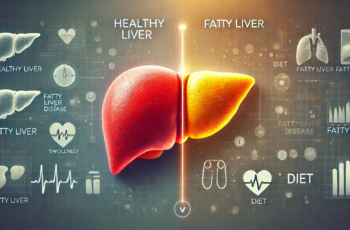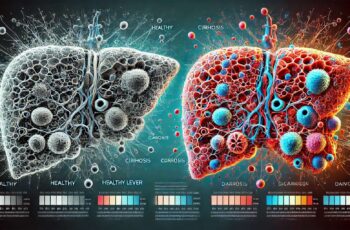Ad Blocker Detected
Our website is made possible by displaying online advertisements to our visitors. Please consider supporting us by disabling your ad blocker.
Liver cancer is a serious and often life-threatening disease that affects many individuals around the world. As one of the largest organs in the body, the liver plays a crucial role in maintaining overall health and wellness. Understanding how to protect your liver from diseases like liver cancer can significantly improve your quality of life. This article will explore various aspects of liver cancer, including its causes, symptoms, diagnosis, treatment options, and preventive measures.
Liver cancer
Liver cancer is a type of cancer that begins in the cells of the liver. The liver is responsible for several vital functions, including detoxifying harmful substances, producing bile for digestion, and storing nutrients. When liver cells become abnormal and grow uncontrollably, they form tumours, which can disrupt the normal functioning of the liver. There are various types of liver cancer, with hepatocellular carcinoma being the most common.
The risk factors for developing liver cancer include chronic liver diseases such as cirrhosis and hepatitis B or C infections. However, lifestyle choices play an equally significant role in influencing liver health. Adopting healthy habits can be pivotal in preventing liver cancer and improving overall well-being.
What is liver cancer?
Understanding liver cancer begins with knowing what it entails. Liver cancer primarily affects people with underlying liver conditions. It may also arise in individuals with healthy livers, albeit less commonly. Usually, liver cancer is categorized into primary and secondary types. Primary liver cancer originates in the liver cells, while secondary liver cancer occurs when cancer spreads to the liver from another part of the body.
Types of liver cancer
There are several types of liver cancer, with each having distinct characteristics:
- Hepatocellular carcinoma (HCC): This is the most prevalent type of liver cancer and typically develops in individuals with chronic liver diseases.
- Cholangiocarcinoma: This type arises from the bile ducts within or outside the liver. Cholangiocarcinoma is less common but is often diagnosed at advanced stages due to subtle symptoms.
- Hepatoblastoma: A rare form of liver cancer that occurs mostly in infants and young children. It usually involves a combination of surgery and chemotherapy for treatment.
Staging of liver cancer
The staging of liver cancer determines how far the disease has progressed. Stages range from I-IV, with Stage I indicating localized cancer that has not spread beyond the liver, while Stage IV signifies advanced cancer that has metastasized to other organs. Understanding the stage helps guide treatment options and prognosis.
Common misconceptions
Many misconceptions surround liver cancer, leading to confusion and stigma. One common myth is that only heavy drinkers develop liver cancer. While alcohol abuse is a known risk factor, numerous individuals with liver cancer do not have a history of heavy drinking. It’s essential to recognize that liver cancer can affect anyone, regardless of their lifestyle choices.
Causes of liver cancer
Several underlying factors can contribute to the development of liver cancer. Identifying these causes is crucial in understanding prevention strategies and increasing awareness about this disease.
Chronic liver diseases
Chronic liver diseases are among the primary causes of liver cancer. Conditions such as hepatitis B and C infections lead to inflammation, damage, and scarring of the liver over time, increasing the risk of cancer. Hepatitis B can be transmitted through blood and bodily fluids, while hepatitis C is often contracted through shared needles or unregulated medical practices.
Alcohol consumption
Excessive alcohol consumption can lead to alcoholic liver disease, a condition that causes inflammation and fatty liver, eventually resulting in cirrhosis. Cirrhosis is characterized by extensive scarring of the liver, making it more susceptible to cancer formation. Limiting alcohol intake and seeking help for alcohol dependency are critical steps in reducing liver cancer risk.
Non-alcoholic fatty liver disease (NAFLD)
NAFLD is increasingly recognized as a significant risk factor for liver cancer. It occurs when fat accumulates in the liver without excessive alcohol consumption. NAFLD is associated with obesity, diabetes, and metabolic syndrome. As rates of obesity rise globally, so does the prevalence of NAFLD, highlighting the importance of maintaining a healthy weight.
Environmental toxins
Exposure to certain environmental toxins can also elevate the risk of developing liver cancer. Aflatoxins, naturally occurring toxins produced by mold found on crops, can contaminate food supplies, and prolonged exposure increases the likelihood of liver cancer. Additionally, industrial chemicals such as vinyl chloride and arsenic have been linked to higher cancer rates.
Liver cancer symptoms
Detecting liver cancer early can significantly improve treatment outcomes. However, because the liver does not have pain receptors, many people may not experience noticeable symptoms until the disease has progressed. Familiarizing yourself with the potential signs can aid in early detection.
Early warning signs
Some of the initial symptoms of liver cancer may include:
- Unexplained weight loss: Sudden weight loss without a change in diet or exercise routine can be a red flag.
- Loss of appetite: Feeling full quickly or experiencing a decreased appetite can signal underlying issues with liver health.
- Fatigue and weakness: Persistent tiredness that doesn’t resolve with rest may indicate an underlying issue, including liver problems.
Advanced symptoms
In more advanced cases, symptoms may become more severe and can include:
- Abdominal swelling: Ascites, or fluid accumulation in the abdomen, can cause discomfort and visible swelling.
- Jaundice: Yellowing of the skin and eyes suggests that the liver isn’t effectively processing bilirubin, a waste product.
- Itching: Unexplained itching on the skin may occur due to increased bile salts in the bloodstream.
Emotional impact
Receiving a diagnosis of liver cancer can be emotionally overwhelming. Patients often experience fear, anxiety, and uncertainty regarding their future. Seeking support from loved ones, joining support groups, or consulting mental health professionals can be beneficial in navigating these emotional challenges. Remember, you’re not alone in this journey.
Liver cancer diagnosis
Diagnosing liver cancer often involves a comprehensive evaluation of medical history, physical examinations, and various diagnostic tests. Early detection is crucial for successful treatment, making awareness of the diagnostic process essential.
Medical history and physical examination
A thorough medical history is essential in diagnosing liver cancer. Physicians will inquire about any existing liver diseases, family history of cancer, and lifestyle factors such as alcohol use and medications. A physical exam may reveal signs of liver dysfunction, such as jaundice or abdominal swelling.
Imaging tests
Imaging tests play a pivotal role in diagnosing liver cancer. Commonly used imaging modalities include:
- Ultrasound: A non-invasive test that uses sound waves to create images of the liver and detect abnormalities.
- CT scan: Computed tomography provides detailed cross-sectional images of the liver, helping identify tumors and assess their size and extent.
- MRI: Magnetic resonance imaging offers even greater detail than CT scans and helps evaluate the liver’s blood vessels and surrounding structures.
Biopsy
In some cases, a biopsy may be necessary to confirm a diagnosis of liver cancer. During this procedure, a small sample of liver tissue is extracted under imaging guidance and examined for cancerous cells. Despite being invasive, biopsies provide critical information about the cancer type and grade, aiding in treatment planning.
Liver cancer risk factors
Identifying and understanding liver cancer risk factors can empower individuals to make informed lifestyle choices that promote better liver health. While some risks are unchangeable, many can be mitigated through proactive measures.
Genetic predisposition
A family history of liver cancer can increase the likelihood of developing the disease. Genetic factors may play a role in how individuals metabolize drugs and alcohol, influencing their susceptibility to liver damage and cancer. Individuals with a family history should discuss their risk with a healthcare provider and engage in regular screenings.
Lifestyle choices
Certain lifestyle choices have a direct impact on liver health. Factors such as diet, exercise, and substance use can either promote or prevent liver damage. Maintaining a balanced diet rich in fruits, vegetables, and whole grains while minimizing processed foods can support liver function. Regular physical activity, even in moderate amounts, contributes to healthy body weight and metabolic regulation.
Chronic viral infections
Chronic infections like hepatitis B and C remain significant contributors to the risk of liver cancer. Vaccination against hepatitis B is highly effective in reducing incidence rates, and antiviral treatments for hepatitis C have shown excellent results in clearing the virus. Prioritizing regular screenings for those at risk can prevent the progression of liver cancer.
Age and gender considerations
Age and gender also play a role in liver cancer risk. Generally, men are more likely to develop liver cancer than women, possibly due to differences in lifestyle factors and biological responses. Risk increases with age, particularly for individuals over 55. Awareness of these trends can promote proactive health screenings among high-risk populations.
Treating liver cancer
When it comes to treating liver cancer, several approaches may be employed based on the cancer’s stage, location, and the patient’s overall health. Treatment decisions should involve discussions between patients and their healthcare teams to determine the best course of action.
Surgical interventions
Surgery is often considered the first-line treatment for liver cancer when feasible. Surgical options may include:
- Partial hepatectomy: Involves the removal of a portion of the liver containing the tumor. This procedure is suitable for patients with localized tumors and preserved liver function.
- Liver transplantation: For patients with severely damaged livers or multiple tumors, liver transplantation may be the best option. Transplantation removes both the diseased liver and the cancer, replacing it with a healthy liver from a donor.
Non-surgical treatments
For those unable to undergo surgery, non-surgical treatments may be viable alternatives:
- Ablation therapy: Techniques such as radiofrequency ablation (RFA) and microwave ablation destroy cancer cells using heat. These methods are minimally invasive and can target small tumors effectively.
- Transarterial chemoembolization (TACE): TACE combines chemotherapy with blocking blood supply to the tumor, limiting its growth. This method is often used for patients with advanced liver cancer.
Systemic therapies
Systemic therapies, such as targeted therapies and immunotherapy, aim to attack cancer cells throughout the body. Targeted therapies focus on specific molecular targets associated with cancer growth, while immunotherapy utilizes the body’s immune system to fight cancer. These options may be incorporated into treatment plans depending on individual circumstances and tumor characteristics.
Liver cancer prevention
Preventing liver cancer requires a multifaceted approach that encompasses lifestyle changes, vaccination, and regular monitoring. By taking proactive steps, individuals can significantly reduce their risk of developing this disease.
Healthy dietary habits
Diet plays a fundamental role in liver health. Emphasizing a balanced diet rich in antioxidants, vitamins, and minerals can support liver function. Foods such as leafy greens, berries, and nuts promote detoxification processes and reduce inflammation. Avoiding excessive sugar, saturated fats, and processed foods can further lower risk factors associated with liver cancer.
Regular physical activity
Engaging in regular physical activity not only supports weight management but also enhances liver function. Exercise improves insulin sensitivity and promotes metabolic health, reducing the risk of conditions like NAFLD. Aim for at least 150 minutes of moderate-intensity aerobic exercise each week, complemented by strength training activities.
Limit alcohol consumption
Reducing or eliminating alcohol intake is crucial for maintaining liver health. If you consume alcohol, do so in moderation, following guidelines that define low-risk drinking. Seek assistance if you struggle with alcohol dependency, as quitting alcohol can dramatically lower the risk of liver cancer.
Vaccination and screening
Vaccination against hepatitis B is an effective means of preventing infection and, consequently, liver cancer. For individuals with hepatitis C, receiving antiviral treatments can clear the virus and reduce cancer risk. Additionally, regular screenings for those at high risk allow for early intervention and improved outcomes.
Conclusion
Improving liver health and preventing cancer are achievable goals through mindful lifestyle choices, early detection, and appropriate medical care. Individuals can take proactive steps toward safeguarding their liver health by understanding the causes, symptoms, risk factors, diagnosis, and treatment of liver cancer. Ultimately, awareness and education are key components in reducing the burden of liver cancer and promoting overall well-being.
💙 Share Health, Spread Hope!
Knowledge saves lives! If you found this information helpful, share it with your friends and loved ones. Raising awareness about liver cancer could help someone detect symptoms early or make informed health choices. Together, we can support better health and stronger communities!
⚠️ Medical Disclaimer:
This content is for informational purposes only and should not be considered medical advice. Always consult a qualified healthcare professional before making any health decisions or starting new treatments.



